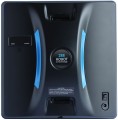Performance
The performance of a cleaning machine is the area that the unit can process in an hour.
Usually, the specs indicate the maximum performance achieved under perfect conditions. It may turn out to be somewhat lower due to the specs of the room, the presence of old dirt and other factors. However, the theoretical difference is usually quite consistent with the actual one. For example, models for 1000 m2/h and 2000 m2/h will differ in performance approximately by two times. So, according to this parameter, it is quite possible to evaluate different models and compare them with each other.
Note that high performance requires a powerful motor and capacious tanks, which affects the dimensions, weight and cost of the unit. Therefore, excessive performance is just as undesirable as insufficient. In addition, more powerful machines usually have a larger working width and are not well suited for rooms with an abundance of narrow passages and nooks and crannies.
As for the actual values, models
less than 1000 m2/h belong to the entry-level. It is the specs that most household machines have (see "Type"). A value
from 1000 to 2000 m2/h is relatively low for professional sweepers and the average for scrubber dryers.
2000 – 3000 m2/h is considered a fairly solid performance, and models of
more than 3000 m2/h is extremely ra
...re. These are mostly high-end sweepers (it is extremely difficult to achieve such characteristics in scrubbers).Motor power
Rated power of the motor installed in the machine.
Most often, in this paragraph, it is the total motor power that is given. However, in units with suction functions, such as scrubber dryers (see "Type"), only the power transmitted to the brushes can be indicated here. In such cases, the total power can be determined by adding the motor power and the suction power (see below). These details should be clarified separately. Also note that in self-propelled models (see above), part of the motor power is spent on moving the unit, which is why the useful power of such machines is lower than that of similar non-self-propelled vehicles. Thus, only models with the same movement format can be directly compared by this parameter— only self-propelled or only non-self-propelled.
In general, higher motor power results in higher efficiency and productivity. However, there is no rigid dependence here, and devices with similar motor specs can differ markedly — productivity, working width, etc. So when choosing, it makes sense to pay attention primarily to these characteristics — especially since for some units (in particular, many robots) the motor power may not be given at all. As for specific power values, in the most modest equipment — in particular, household scrubbers — it
does not exceed 600 W;
600 – 1200 W can be called an average,
1200 – 1800 W is above averag
...e, and more solid values are found in powerful heavy units.Voltage
The voltage of the battery used in the machine with the corresponding type of power supply. This parameter is not key when choosing; it may only be needed when looking for a third-party charger or a replacement/spare battery, as well as for specific calculations related to capacity (see below).
Noise level
The noise level created by the harvesting machine during operation.
Low noise levels are important for the comfort of both the operator and others; the latter is especially true in some specific places such as hospitals or kindergartens. On the other hand, the higher the power, the louder, as a rule, the unit operates and the more difficult it is to reduce this noise to a certain level; despite the fact that in many cases high volume operation is not a particular problem. So you should specifically look for a “quiet” cleaning machine only if a low noise level is more critical for you than high cost and/or reduced power.
When assessing specific loudness values, it is worth considering that the decibel used to indicate the noise level is a non-linear quantity. Therefore, the easiest way is to evaluate specific values using comparative tables. Here's a simplified table for the range that most modern harvesting machines fit into:
55 dB - background noise in an office without special noise sources;
60 dB - loud conversation;
65 dB - city street with average traffic intensity;
70 dB - a conversation between several people in a raised voice.
75 dB – high power vacuum cleaner.
80 dB - traffic noise on a busy street.
Power cord length
The length of the mains cord provided in the machine with the appropriate power supply (see "Power supply").
A long cord allows you to move further away from the outlet but can get tangled under your feet and create inconvenience. Therefore, manufacturers choose the length of the power cord by the specs of a particular model: for example, a window robot (see "Type") is quite enough 4 – 5 m, and in heavy scrubbing units, the length of the wire can exceed 20 m.
Weight
The total weight of the cleaning machine. Usually, weight is indicated with empty tanks for detergent, waste, fuel, etc. At the same time, additional equipment, such as side brushes, may or may not be taken into account. Such equipment has a very small weight compared to the machines themselves. And, when installed/removed, does not seriously affect the mass of the entire machine.

